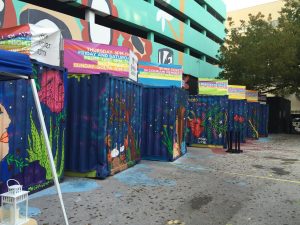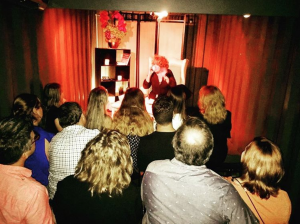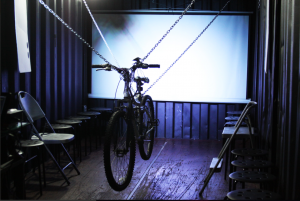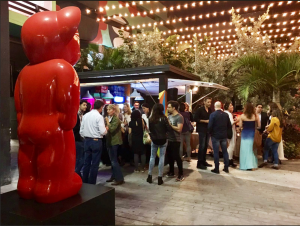Posted May 3, 2017
By ETTY GROSSMAN
Originally, those large standard-sized international shipping containers were used to ship, store, and handle products and goods. But soon creative people began to develop them into eco-friendly apartments and business locations. And now they are being used as ready-made mini-stages for live theater.
Yes, you read it right. Using seven re-cycled shipping containers parked on an open loading dock, Miami’s Centro Cultural Español (Spanish Cultural Center) introduced the latest and most revolutionary way of experiencing theater: Micro Teatro, also known as Microtheater.
Micro Teatro offers a program of seven 15-minute plays Thursdays through Sundays.
Each work is presented six times a night, with a brief break, in a continuous session. Guests can choose the number of plays they want to see per night and the times that fit best.
This idea came to Miami from Spain. In 2009, a brand new theater concept was born in Madrid: “Microteatro Por Dinero,” where 50 artists, among them directors, playwrights and actors, presented short plays preformed in different rooms of an old brothel in order to earn money by doing what they enjoyed the most.
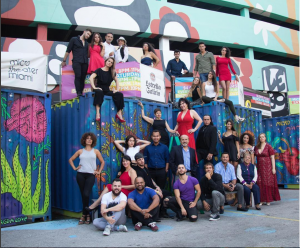
The entire Microtheater team for this month’s season “A Taste of Passion,” posing over their unique shipping container stages (Photo courtesy of Microtheater).
“Miguel Alcantud, who was the founder and coordinator of the project, wanted to create a space to bring culture and theater to the streets; a space where artists could be recognized and rewarded for what they did,” explained Marlen Muñoz, coordinator of Microtheater Miami.
“Spanish actor, Jorge Monje, saw Miami as a hip and hot city to do the same thing, so in 2012 he founded Microtheater Miami in partnership with CCE Miami.”
When the project started, Microtheater Miami wasn’t the ongoing event it is today. Monje put on the show whenever he was in the mood for it. Sometimes he would do it twice a month, some others he would take one month off and then return this added a sense of novelty and created curiosity around the project. This garnered demand within the community for Microtheater.
“Today, we have plays during the entire year, except if it happens upon Christmas Day or New Year’s,” said Muñoz. “We had to do it on a daily basis because now we are attracting more of the Anglo market, which we didn’t before.”
During the entire year, Microtheater presents 12 seasons, one per month, divided into two different sessions: Prime and Golfa, a session for spicier plays. Each session presents seven different plays or 14 plays per season.
Since this theater format is so different from traditional plays, most of the plays are original material written only and especially for Microtheater.
“The process to get our programing for each season is quite unique,” said Muñoz. “First, we come up with themes for the season, then we do an open call through our social media and online platform and finally people start sending us ideas of any kind.”
A reading committee evaluates and selects the best plays.
Contributors don’t have to be a professional writer in order to have a play performed at Microtheater.
The only requisite is to have a play with a corresponding beginning, middle and end and a high level of creativity.
Authors will receive 10 percent of the box office sales.
Once the committee decides on the plays for a season, the directors choose their favorite plays and make the arrangements or adaptations needed.
“Everything starts with the script, that’s why it is so important to fall in love with the story first,” said Carlos Villar, Microtheater director and actor. “After that, you can start looking for other core components such as your actors and the set.”
“Finding the right actors is one of the most challenging things for Microtheater directors,” said Argentine Microtheater director Kevin Kass. “Not only because they are the essence and life of the story, so they must be very good, but also because they are the ones that attract people to the shows.”
“Another problem with finding actors is the salary,” Kass continued. “Doing Microtheater for a living is not enough so, unfortunately for the majority of us, this can only be a part-time job.”
Even though actors and directors must have other jobs, they continue to open a space in their schedules to be part of this project because they love what they do and they say they have a lot of fun.
“These performances are an excellent workshop for actors — it is like a boot camp,” said Vivian Morales, an electrical engineer and Microtheater actress. “You have to put the same energy throughout the six plays you do in one night, but getting six different audiences every night also gives you the opportunity to try new things and maybe improvise a bit.”
For Cuban actress Belkis Proenzas, the distance between the stage and the public is what excites her the most. “It is so short that we can feel the audience reactions without even looking at their faces, and I guess that it is a similar experience for them because they are right on the play.”
“I’m a huge fan of this new concept,” said Alberto Rivas, a frequent Microtheater visitor. “I even like it more than traditional theater. It is so intimate that you feel as if you were part of the play, also, it is fast, dynamic and quick, just as today’s technology.”
Microtheater not only promotes the local talent and entertains the community, it also serves as a space for people to hang out and learn from different cultures. Besides the plays, Microtheater also offers workshops and other entertainment events, which are commonly free or at least affordable for everyone.
“Sadly, this new concept of patio entertainment isn’t something constant,” explained the project coordinator of the CCE, Maybe De La Torre. “Since we only charge $5 per play, we rely on grants to do those events; so every time we receive a grant we go ahead and plan something for the community.”
“For example,” De La Torre continued. “At the beginning of the year, we got a $1,000 grant from the Downtown Development Authority, which allowed us to host an amazing belly dance night.”
Since Microtheater is a non-profit organization, it can apply for those grants, which are needed because 70 percent of its box office goes directly to the talent.
It also uses sponsors to contribute more money for the program. Right now “Estrella Galicia,” a brand of pale large beer and “1906 Reserva Especial,” another beer company, are the biggest supporters.
“We are looking forward to finding a sponsor just for the patio entertainment,” said Muñoz. “That would allow us to do these innovative events on a daily basis.”
This is one of the program objectives for the future. Microtheater Miami wants to do more experimental things within the 15 minutes plays and with outdoor entertainment such as local bands and restaurants.
“By experimental things, we mean trying new ways of presenting theater within the 15 minutes’ format,” said Muñoz. “We want actors to play a little bit more with the public, mix and match their acting with music, and so many other things that I can’t reveal yet.”
Although the theater’s managers are working on introducing new things, their greatest challenge remains the same — reaching the English-only speaking audiences and bringing well-known actors to the plays.
“We don’t get much marketing or publicity from the media,” recognized Muñoz. “Microtheater depends on word-of-mouth for publicity because we can’t invest our grants in advertising or promoting our activities; that’s why the we believe that with the participation of famous actors, directors and writers we could increase our audience.”
“This whole Microtheater idea has been out there for five years now, and it hasn’t got the attention it deserves,” said Francisco Tardío, director of the CCE. “We are very proud of what we have accomplished, but we feel people hasn’t taken advantage of what we are offering. The project is constantly developing new audiences for theater in Miami due to its low-risk, inexpensive, but creative proposition, and it is giving actors, writers and directors a space to experiment new things.”
“So, for people who are trying to find adventurous and creative things to do in Miami, I would certainly encourage them to give Microtheater a chance.”
If You Go
- Microtheater Miami.
- Address: 1490 Biscayne Blvd., Miami, Fla. 33132.
- Parking: NE 2nd Avenue between NE 14th – 15th Streets / Flat rate of $8 per hour only for Microtheater visitors.
- Price: $5 per play.
- Capacity: 15 viewers per container.
- Ticket purchase: Online at http://microtheatermiami.com/en/box-office/ or at the ticket office.
- Hours: Prime Time session: Thursdays through Sundays 8 to 11 p.m.
Golfa session: Fridays through Sundays, 11 p.m. to 1 a.m.
- Current Season: “A Taste of Passion.”
- Language: Spanish and English.
- Food: Arepas and Hamburgers at the Patio.
- Drinks: Beer, wine and soft drinks at the Bar Lounge.

